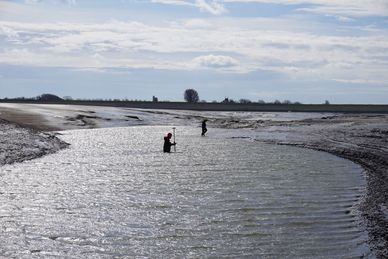PR 00297: verschil tussen versies
Geen bewerkingssamenvatting |
Geen bewerkingssamenvatting |
||
| (17 tussenliggende versies door 2 gebruikers niet weergegeven) | |||
| Regel 1: | Regel 1: | ||
[[Bestand:LCHT.jpg|miniatuur|388x388px|D-GPS measurements (traditional method for determining sediment height) taken in the field by students.]] | [[Bestand:LCHT.jpg|miniatuur|388x388px|D-GPS measurements (traditional method for determining sediment height) taken in the field by students.]] | ||
The Netherlands has laid down guidelines for nature conservation and biodiversity in the Natura2000 Management Plan for Delta Waters. The Dutch waters and delta areas make up two-thirds of the Natura2000 areas and form an important habitat for coastal breeding birds and are indispensable for migratory birds as a resting area and place to forage. For nature management to be more effective, monitoring the dynamics of estuarine nature in the delta management cycle is of great importance. It offers public professionals the opportunity to adapt system designs and/or system interventions. | |||
For project monitoring conventional measuring techniques are used which are often labour-intensive and therefore costly. To make this process more efficient the project ''Low cost monitoring with high tech innovations'' looks into the opportunities for new technologies to help make monitoring faster and/or more accurate . The aim of this project is to investigate whether monitoring nature restoration projects can be made more efficient. The key question is whether the use of new measuring techniques will enable more or different types of data to be collected at lower cost, over larger areas and with better temporal resolutions. In other words, more understanding of the system {{Cite|resource=Bestand:DK 050 Projectvoorstel LCHT final V3 bvs mve 210617.pdf|name=(HZ 2017)|dialog=process-file-dialog}}. | |||
At three locations in the Westerschelde estuary (Baalhoek, Knuitershoek and Perkpolder) experiments have been carried out with innovative measuring techniques to gain a better understanding of factors that influence the functioning of tidal ecosystems. Data from nine key parameters were collected: (1) bird numbers, (2) benthos as bird food, (3) benthos as bioturbator, (4) medium-scale morphology, (5) large-scale morphology, (6) short-term (daily) changes in sediment height, (7) soil density, (8) hydrodynamics: currents / waves and (9) sediment concentrations in water. | |||
{{Project config}} | {{Project config}} | ||
{{Project | {{Project | ||
|Name=Low cost | |Name=RAAK Publiek: Low cost monitoring with high tech innovators | ||
|Supercontext= | |Supercontext=PR_00343 | ||
|Start date=2018/01/01 | |Start date=2018/01/01 | ||
|End date= | |End date=2021/05/31 | ||
|Summary= | |Summary=Als gevolg van de Natura 2000-maatregelen die de Nederlandse overheid heeft genomen om de natuurlijke habitats in het hele land te verbeteren, is het monitoren van verschillende (beschermde) gebieden belangrijk geworden. Om dit proces efficiënter te maken wordt in het project 'Low cost monitoring with high tech innovations' gekeken naar de mogelijkheden van nieuwe technologieën om de monitoring sneller en/of nauwkeuriger te maken. Dit wordt gedaan door verschillende nieuwe technieken in het veld te testen en te vergelijken met de traditionele monitoringsprotocollen. | ||
|Show summary=Nee | |Show summary=Nee | ||
|Contact person= | |SummaryEn=As a result of the Natura 2000 measures taken by the Dutch government to improve natural habitats around the country the monitoring of various (protected) areas has become more important. To make this process more efficient the project 'Low cost monitoring with high tech innovations' looks into the opportunities for new technologies to help make monitoring faster and/or more accurate. This is done by testing various new techniques in the field and comparing them to the traditional monitoring protocols. | ||
|Stakeholder=STKH 00001,STKH 00064,STKH 00061 | |Contact person=Gebruiker:Lage0009 | ||
|Show extra= | |Stakeholder=STKH 00001,STKH 00064,STKH 00061 | ||
|Show extra=Ja | |||
|Show navigation tree=Ja | |Show navigation tree=Ja | ||
|Show new page button=Ja | |Show new page button=Ja | ||
Huidige versie van 24 aug 2022 om 15:24
The Netherlands has laid down guidelines for nature conservation and biodiversity in the Natura2000 Management Plan for Delta Waters. The Dutch waters and delta areas make up two-thirds of the Natura2000 areas and form an important habitat for coastal breeding birds and are indispensable for migratory birds as a resting area and place to forage. For nature management to be more effective, monitoring the dynamics of estuarine nature in the delta management cycle is of great importance. It offers public professionals the opportunity to adapt system designs and/or system interventions.
For project monitoring conventional measuring techniques are used which are often labour-intensive and therefore costly. To make this process more efficient the project Low cost monitoring with high tech innovations looks into the opportunities for new technologies to help make monitoring faster and/or more accurate . The aim of this project is to investigate whether monitoring nature restoration projects can be made more efficient. The key question is whether the use of new measuring techniques will enable more or different types of data to be collected at lower cost, over larger areas and with better temporal resolutions. In other words, more understanding of the system (HZ 2017).
At three locations in the Westerschelde estuary (Baalhoek, Knuitershoek and Perkpolder) experiments have been carried out with innovative measuring techniques to gain a better understanding of factors that influence the functioning of tidal ecosystems. Data from nine key parameters were collected: (1) bird numbers, (2) benthos as bird food, (3) benthos as bioturbator, (4) medium-scale morphology, (5) large-scale morphology, (6) short-term (daily) changes in sediment height, (7) soil density, (8) hydrodynamics: currents / waves and (9) sediment concentrations in water.

